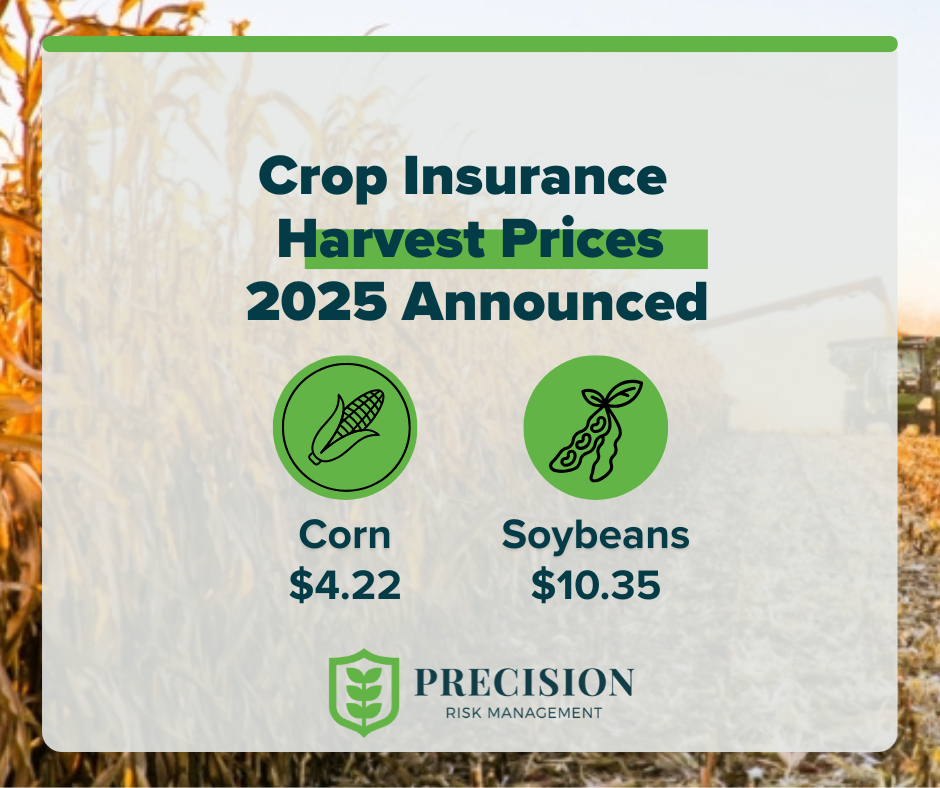What They Mean for Your Risk Protection
The harvest price discovery period has officially wrapped up, and the final prices for crop insurance are locked in. With lower market prices across corn, soybeans, and wheat, the true value of your spring decisions is now coming into focus. This is where coverage decisions either pay off or leave gaps. Let’s break down what the new harvest prices mean and how to take full advantage of your policy moving forward.
Final 2025 Harvest Prices:
- Corn: $4.22
- Soybeans: $10.35
Harvest Prices vs. Spring Prices:
| Crop | Spring Price (Feb) | Harvest Price (Oct) | Change |
| Corn | $4.70 | $4.22 | ↓ $0.48 |
| Soybeans | $10.54 | $10.35 | ↓ $0.19 |
This year, all three commodities saw a decline from the projected spring price to the fall harvest price.
In this article, we will explore important topics relating to these prices and how they affect your crop insurance:
- How this changes your crop insurance guarantees
- How this changes your implied bushel per acre guarantee and how to use it
- Why submitting Production Reports Early helps your policy
- How PRM can help if you think you are in a loss situation
Locked-In Protection with Revenue Protection (RP) Policies
With RP, your revenue guarantee is based on the higher of the spring or harvest price. That means:
- If harvest prices go up, your coverage increases.
- If harvest prices go down (as they did this year), your revenue guarantee stays based on the higher spring price.
So even though commodity prices dropped, you’re still protected at:
- Corn: $4.70
- Soybeans: $10.54
- Wheat: $6.55
This ensures that even if prices decline, you don’t lose protection. It’s one of the key advantages of RP compared to yield protection.
Corn Revenue Guarantee Example*
If your APH for corn is 200 bu/acre and you elected 80% coverage, your revenue guarantee is:
200 BU × $4.70 × 80% = $752/acre
If you end up harvesting 170 bushels/acre and the harvest price is $4.19, your actual revenue is:
170 BU × $4.22 = 717.40$/acre
Since that’s below your guarantee, you’d receive a crop insurance indemnity of:
$752 – $717.34 = $34.66/acre loss payment
Why You’re Actually Covered for More Bushels Now
When fall prices drop below spring’s projected price, your Revenue Protection (RP) policy will effectively protect more of your crop in terms of bushels.
That’s because your guaranteed revenue stays fixed in dollars, but now those dollars stretch further when divided by a lower harvest price. Here’s what that looks like in real numbers at a 100% share:
Corn Bushel Guarantee Example*
180 Guaranteed BU/Acre x $4.70 (Projected Price) = $846 Guaranteed Revenue/Acre
Harvest Price Dropped to $4.22
$846/$4.22 = 200.47 BU New BU Guarantee
That’s an extra 20.47 bushels per acre protected, just because the corn price dropped even though your coverage percentage and APH stayed the same.
Soybeans Bushel Guarantee Example*
45 Guaranteed BU/Acre x $10.54 (Projected Price)= $474.30 Guaranteed Revenue/Acre
Harvest Price Dropped to $10.35
$474.30/$10.35= 45.83 BU New BU Guarantee
That’s an .83 additional bushels per acre of protection. Not nearly as large as the corn example, but it still makes a significant bushel guarantee protection difference.
Why Your Bushel Guarantee Increase Matters
This is one of the most overlooked advantages of Revenue Protection (RP) coverage. When harvest prices fall, your bushel guarantee increases to maintain your full revenue guarantee. This provides a larger cushion and raises the chances of receiving an indemnity payment.
This new bushel guarantee becomes an indicator that you might have a claim with a RP policy. If the harvest yield is below the new bushel guarantee, you may be in a loss situation. In that scenario, it is time to contact your Risk Management Advisor immediately to let them know of a potential loss.
Submit Production Reports Early and Avoid Missed Claims
With prices down across the board, the threshold for yield loss to trigger a payment is lower. You have a small window of time to submit a Notice of Loss and make certain that it is accepted. As harvest wraps up, submitting your production reports early is one of the most impactful steps you can take. Here’s why it matters:
- Faster Claims Processing: Early reporting means we can process your claims sooner and help you cover costs from losses quickly, if it is determined you are in a loss situation.
- Accurate APH for 2026: Your Approved Yield drives next year’s coverage. Early submission ensures clean, complete records.
PRM is Here to Help
As the 2025 crop year comes to a close, this is the ideal time to evaluate how your crop insurance policy performed and what adjustments might be needed for the year ahead. Submitting your production reports early allows your PRM advisor to assess potential claims, ensure your APH records are accurate, and start building a stronger risk strategy for 2026.
With the right data and guidance, you can protect your revenue and make more informed decisions. PRM is here to support your operation every step of the way, helping you finish the year strong and prepare for what comes next. Contact your Risk Management Advisor today with any questions. Your PRM Advisor can look up your specific crop, practice, and area Harvest Prices.
*All examples are for illustrative purposes only to showcase the fundamentals of crop insurance. Not an actual representation of coverages or indemnity scenarios. Each policy is unique and needs to be evaluated by a licensed agent and adjuster for final indemnity situations.



